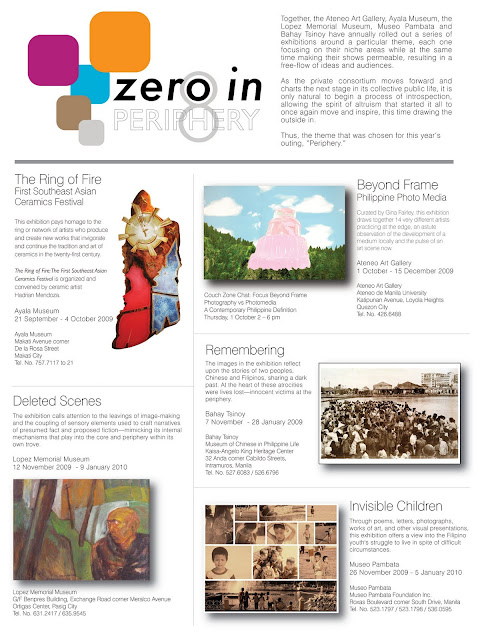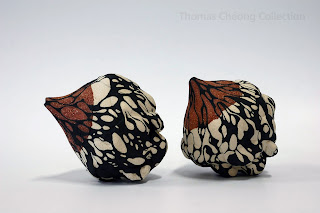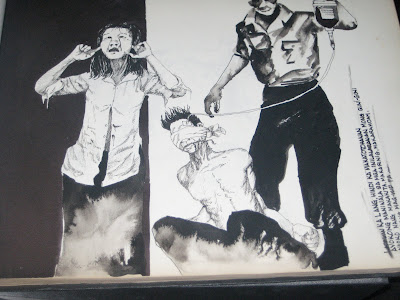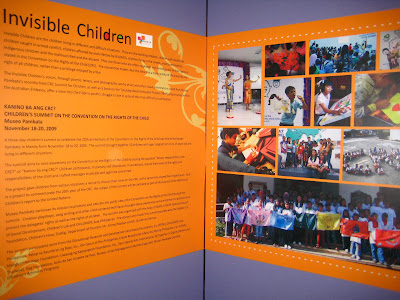Payak lang ang aking panata.
Nakapapaso ang ganitong pakikidigma
Sa pagsubok, ang pagsagupa
Sa dambuhalang alon sa karagatan,
Ang pakikipagbuno sa di nahahawakan.
Ito ang malubha kong takot.
Di ko alam kung paanong
Susuyurin ang mga sagot ng daigdig,
Lalakbayin ang di mahanap na sulok
at lawak ng nasasakupang ligalig.
- ARVIN ELLO, mula sa tulang "Batong Nakaharang sa Daan"
Zero In art exhibition series celebrates its 8th year this 2009-2010. 4 museums & a gallery collaborate in an art exhibition with the main theme dubbed "Zero In: Periphery." These 5 art venues namely: Ayala Museum, Ateneo Art Gallery, Bahay Tsinoy, Lopez Museum and Museo Pambata, hold independent exhibitions having their own interpretation of the theme. It is a festival of arts and culture that is moving and inspiring, touching the deepest recesses of our thoughts and consciousness as Filipinos, as members of the society. The exibitions also aim to foster awareness of our human frailties and strength of character.
A. Ayala Museum
The Ring of Fire: The First Southeast Asian Ceramics Festival
(September 21-October 4, 2009)
Masuyong dinidilaanNg nagsasayaw na apoyAng piraso ng kahoy..................................Mapapawi ang apoyAt magbabaga itoNang napakaningning.- ROFEL BRION, mula sa tulang "Ganito Lamang Naman"
ASEAN potters are gathered for the first time in the Philippines. 16 Filipino potters and 10 other Southeast Asian ceramic artists exhibit their works in an international show dubbed Ring of Fire at the Ayala Museum. Artists had a 2-day seminar-workshop where they shared their knowledge regarding their individual techniques and creative process on September 22 & 23.
Sixty-four (64) ceramics masterpieces were displayed that attest to the power, passion and character giving a distinct identity to the ASEAN ceramic artistry. Fifteen (15) Participating artists in the Philippines include: Jon and wife Tessie Pettyjohn of Pansol; Hadrian and wife Camille Mendoza of Makiling; Jaime de Guzman of Candelaria, Quezon; Colorado-based Nelfa Querubin of Iloilo; Manila-based sculptress Julie Lluch of Iligan; Pete Cortes of Bulacan; Pablo Capati of Batangas; Joe Geraldo of Bacolod; Mark Valenzuela of Dumaguete; Winnie Go and Joey de Castro of Makati; Siegrid Bangyay and Lope Bosaing of Sagada.
Among the other ASEAN artists who participated are: Ahadiat Joedawinata (Indonesia), Peter Low, James Seet, Lileng Wong, and Yeow Seng Cheah (Malaysia), Teck Heng Tan and Thomas Cheong (Singapore), Bathma Kaew-Ngok (Thailand), and Bao Toan Nguyen (Vietnam).
“The primary goal of this project is to foster a community among Southeast Asian peoples that celebrates both the diversity and unity of the region through the art and craft of pottery,” says Hadrian Mendoza, recipient of a Toyota Foundation networking grant in November 2007. He also believes that gathering the artists together in this event will enable to revive traditional knowledge and skills in pottery and at the same time, share new techniques and practices among contemporary ceramic artists in the ASEAN region.
Mendoza has established strong linkages with various communities of potters in the Philippines, as well as with the various contemporary potters in Cambodia, Indonesia, Laos, Malaysia, Philippines, Singapore, Thailand, and Vietnam. But he is also on the lookout for more modern practictioners of this art form in Brunei and Myanmar. Potters are enjoined to have constant active exchanges thru the website, http://www.seapots.com.
Sponsoring the exhibition are Toyota Foundation Japan, Philippine High School for the Arts, Filipino Web Services, www.handrianmendoza.com, and Crown Plastic Products, Inc.
As part of the Zero In exhibition series, Ayala Museum showcases its permanent collection in A Millennium of Contact, giving a historical perspective to contemporary ceramics.
Ayala Museum is located at De la Rosa St. corner Makati Avenue, Greenbelt Park, Makati City. For more information, please call (632) 757-7117 to 21, or visit the Ayala Museum website.
Beyond Frame: Philippine Photomedia
(October 1-December 15, 2009)
A picture is not thought out and settled beforehand. While it is being done it changes as one’s thoughts change. And when it is finished, it still goes on changing, according to the state of mind of whoever is looking at it. A picture lives a life like a living creature, undergoing the changes imposed on us by our life from day to day. This is natural enough, as the picture lives only through the man who is looking at it.
- Statement of PABLO PICASSO in his conversation with Christian Zervos, 1935. Also republished in Picasso on Art, ed. Dore Ashton (1972)
Beyond Frame: Philippine Photomedia, curated by Gina Fairley, showcases works by 14 different artists who practice the traditional photographic medium to contemporary photo-ased art installations. Through photography, they weave narratives and concept of the self and identity. Artworks span over 3 decades. It is amazing to see how artists look and take photography to the next level of art perception and concept.
Featured in Beyond Frame are works executed using different forms of photography by Poklong Anading, MM Yu, Romina Diaz, Ringo Bunoan, Christina Dy, Lena Cobangbang, Gina Osterloh, Rachel Rillo, Steve Tirona, Lani Maestro, Mario Co, Norberto Roldan, Gerry Tan and Tony Twigg.
This exhibition opens our eyes to the many ways to capture images and recording memories involving photography - there is banner-art, found negatives, studio images, the use of double exposure, duratran lightboxes and installation, video and wall-drawing, collage, drawing and painting. Beyond Frame shows us works that were 'created' beyond what photos have 'remembered.'
Fairley believes, "Anyone can pick up a camera today with availability of digital technology. These artists, rather, push our understanding of photography beyond a mere 'recording of the real'. Caught between the first world's ever-increasing sophistication of imaging technologies and a culture of tech-piracy and make-do aesthetics, the Philippines offers a dynamic discussion on contemporary photomedia from a regional perspective."
This exhibit already premiered at the UTS Gallery Sydney (September 2008) except that the wall-drawing of Christina Dy is done on a specific wall area within the space of the gallery. It was then moved to Bendigo, Australia to continue art relationship with La Trobe University before showcasing here in Manila.
Ateneo Art Gallery is located at Ateneo de Manila University, Katipunan Avenue, Loyola Heights, Quezon City. For more information, please call (632) 426-6488, or visit the Ateneo Art Gallery website.
Deleted Scenes
(November 12, 2009-January 9, 2010)
Assuming that we are dealing with an author, is everything he wrote and said, everything he left behind, to be included in his work? This problem is both theoretical and practical.
- MICHEL FOUCALT, What Is An Author?
Deleted Scenes aims to bring to our attention things that have been neglected, forgotten, omitted. This includes collection of works that have not been out in the open for the longest time. It is but apt for us to see what's behind the dark curtain, closet or wall that tries to expose itself to be known. Sometimes our drawer or cabinet keeps our valuables or items that cannot be bought by money, or that we have forgotten to take out, and seems to have been buried in the abyss of neglect. Then you'd realize one day that there is one thing that just hides itself in the corner of our cabinet.
The sketchbook of Al Manrique (1946-2006), filled with editorial drawings, is seen for the first time in this exhibition. Gloves are provided for viewers to use to flip the pages, handling the works with utmost care. Manrique's drawings (pen & ink/ inkwash) evoke the political, social and economic situation of our country since the Martial Law era. Manrique belonged to the Social Realist group of artists that depict the realities and issues besetting our country in their works. You'll notice in his subjects the peasants' struggles, workers' sentiments, labor power, country's struggles against opportunists.
Big magnificent paintings of Lyle Buencamino can also be seen here. He based them on real photos from different scenes of LVN Pictures productions which are also in the library's collection. These films are (1) Aling Kutsero (1956) starring Nida Blanca, Nestor de Villa and Leroy Salvador, (2) Anak ni Waray (1958) starring Nida Blanca and Nestor de Villa, and (3) Edong Mapangarap (1950) with Pogo and Togo. When cameras became accessible and photography gained popularity, it has somehow replaced painting because it is easier to capture images and scenes. Unlike in the olden times when artists had to paint people who are stiff and frozen until the work is finished. But here, the artist twisted the process: from photography to paintings.
Filipino filmmaker Sari Lluch Dalena and Filipino-American video artist Camilla Benolirao Griggers collaborated on a film, Memories of a Forgotten War: A Documentary on the Philippine-American War of 1899. This film tried to record historical details in portraying accurate events. A war such as the one depicted here is the kind of war being forgotten, being deleted from the memory. Because not everything is written in History books. Dalena & Griggers aimed to reveal the forgotten to be remembered and known.
Another documentary film is made by Dada Dacot about her mother's preparation for an interview at the US embassy for her visa. This film is part of her research on Filipinos and international migration.
What has struck me also in this exhibition is the parade of old books displayed on extended shelves. I have loved browsing at old books and my eyes wandered in checking interesting titles one by one. About 913 books are displayed for this exhibit. On the periphery, some titles have boldly spoke to me. A name that rang a bell, as his name was used in a very small theater in Cultural Center of the Philippines that houses about 96 seats. His name is Dr. Manuel E. Conde who wrote a Spanish book entitled, Dichos ciertos... y ciertos dichos, that presents sayings in alphabetical order, following the first word of the sentence. Tanghalang Manuel Conde is also known as the Dream Theater in CCP.
There have been many books that compile quotations by famous people. The New Dictionary of Thoughts: A Cyclopedia of Quotations (1961) is one that also caught my attention. Originally compiled by Tyron Edwards, this book proudly states that quotes come "from the best authors of the world, both ancient and modern, alphabetically arranged by subjects." With this in mind, you would not ignore this particular book. Quotations were carefully selected. A chart can be used to serve as 'a quick guide to major subjects.' Subjects are found along the radii of the circle and the page references along the circumference. Although not all subjects were included in this circle, topics are alphabetically arranged except for the list in the chart.
Lastly, I could not ignore the pages that Harper's Weekly: Journal of Ciilization had written about the Philippines. I have seen here that a newspaper from New York featured our country and our leaders quite a lot of times by American journalists and editors. They even highlighted scenes depicting our country's situation on their front page. Sold at 10 cents per copy and $4 a year in 1898, Harper's Weekly was one of the respected publications across New York that started in 1856. I also noticed that based on the pages of Harper's Weekly, only a few photos were used. Most of the images were drawings and paintings done by hands. Unlike now, with the rise of media & technology, only a few drawings done by hand can be seen in newspapers and magazines, but mostly are illustrations done using computer softwares.
Lopez Memorial Museum is located at G/F Benpres Building, Exchange Road corner Meralco Avenue, Ortigas Center, Pasig City. For more information, please call (632) 631-2417 or 635-9545, or visit the Lopez Memorial Museum website.
D. Bahay Tsinoy
Remembering
(November 12, 2009-January 9, 2010)
May mga sandaling ganap ang walang pag-iral.Hindi maaaring magpakapalalo ang liwanagpagkatapos ng bangungot ng gabing bumuhosang dalamhati ng kalawakan sa lungsod ng bakal.- REBECCA AñONUEVO, mula sa tulang "Sala-salabid"
Remembering reflects upon the stories of Chinese and Filipinos, two peoples sharing a dark past from countries that attacked and invaded their territories. Both stood each other in their defense of freedom, emerging from the ashes of war with a certainty that the future generations will never suffer the same fate.
Nanjing Massacre of 1937 is considered one of the bloodiest moments in China during World War II. Included in this double exhibit, Memory of Nanjing also shows images and symbols that saw the anguish and pain of Chinese in the hands of the Japanese soldiers. About 300,000 lives were lost.
The Japanese occupation of the Philippines in 1941 to 1945 is considered one of the brutal and destructive times suffered by Filipinos. Families were killed mercilessly and homes were burned down by Japanese soldiers. This ignited the Battle of Manila. Japanese troops bent their frustration and anger on the piteous civilians caught in the crossfire, including children and pregnant women.
In the opening of this exhibition, Ambassador Miguel Perez Rubio, an 85-year old veteran and the late president Corazon Aquino's protocol chief, shared his personal experiences of the war and asked, "The war dead have been buried. Are we now to bury history as well?" A formal apology from the Japanese government is required so that we can attain real peace and reconciliation amongst the two nations. It is just fitting to compensate for the 120,000 Filipinos (including children) that were atrociously killed and many comfort women who were gang-raped, including those pregnant, by these Japanese soldiers.
This exhibition reminds us that violence does not solve conflict, nor does it bring peace. It also highlights the darkest hours of both China and the Philippines and brings us to the past our forefathers have endured during the wars amidst the crises. It was a horrible past that can never be forgotten but calls for forgiveness so that involved countries can move on.
Location:
Bahat Tsinoy is located at Kaisa-Angelo King Heritage Center, 32 Anda corner Cabildo Streets, Intramuros, Manila. For more information, please call (632) 527-6083 or 526-6796, or visit the Bahay Tsinoy website.
Invisible Children
(November 26, 2009-January 5, 2010)
Tila mga bubogna nakakubli sa buhanginang kanilang wika,ang kanilang halakhak.- JIM PASCUAL AGUSTIN, mula sa tulang "Dayuhan"
The younger generation is the focus of Museo Pambata's Zero In exhibition called Invisible Children. It brings to the fore children living in desperate and difficult situations, often neglected and deprived of their rights as stated in the Convention of the Rights of the Child (CRC). They are the working children, children with disabilities, children caught in armed conflict, children affected by and infected with HIV/AIDS, children living in the streets, prostituted children, indigenous children, homeless children, the malnourished and the abused.
It seeks to remind us that the rights of children is a basic human need for quality life, which is only enjoyed by a privileged few. All children must have access to these rights stated in detail in CRC. The exhibit shows us the voices or messages of the children through letters, poetry, various works of art, video and other visual representations. It gives us a picture that despite their circumstances, hope is not far behind - that there is still a bright future waiting to unfold for these children.
The opening exhibit on November 26, 2009 also marked the launching of the book, Tutubing Bakal/Tutubing Bakwit: a collaborative peace helicopter project sponsored by the Australian Embassy. In the first phase of the project, Museo Pambata, together with Alwin Reamillo and 4 Australian artists, namely Jon Bradshaw, Madeleine Challender, Leah McManus and Veronika Mihalj, transformed a decommissioned war helicopter in the museum's playground to symbolize for peace. Creative workshops were conducted by the artists to street children, partner organizations and schools.
In the second phase of the project, Alwin Reamillo was joined by Arnel Agawin, a Hong Kong-based Filipino artist and Madeleine Challender of Australia, to convert the helicopter's interior into an interactive peace shrine. Postcards, messages and other artistic offerings can be seen inside the big tutubing bakal. Together with Don Salubayba, a Filipino artists, this particular tutubi project is part of the whole playground concept in Museo Pambata called Palipalaruan.
The publication is distributed for free to key community organizations, children's museums, libraries across the Philippines, with the support of the Embassy's Strengthening Grassroots Interfaith Dialogue and Understanding program (SGIDU).
Prior to the opening, a 3-day children's summit called "Kanino ba ang CRC?" was held at Museo Pambata in Manila to commemorate the 20th anniversary of CRC from November 18-20, 2009. The summit brought together 50 children with ages ranging from 11 to 16 years old living in difficult situations.
Location:
Museo Pambata is located at Roxas Boulevard corner South Drive, Manila. For more information, please call (632) 523-1797, 523-1798 and 536-0595, or visit the Museo Pambata website.
Zero In, as a consortium art exhibition, is undoubtedly one of the biggest I know, believed to be the longest running today on its 8th year. The Zero In series is to be valued for its strong statement, bold in executing sub-themes as each exhibit carries a deeper meaning in exposing social and political realities and elevating Philippine art and creativity.
In my frequent visits to art museums and galleries, this consortium art project is something to look forward to every year. You get to discover different styles of artists rendering their subjects and expressing their ideas as they try to discover the 'self' in us all. It speaks to us as as Filipinos, as a nation, to look back to our past, recognize what we have at the present and be expectant of what the future holds for us. The exhibition also helps us to find our bearing, where to find our own personal significance beyond the space of an art object, mapping our existence in the timeline.
Zero In: Periphery enjoins us in the act of Remembering the Deleted Scenes Beyond the Frame of our history as Invisible Children make their presence felt in The Ring of Fire.
+ Follow me on Twitter and join my Facebook Page. +










































































8 comments:
loved your virtual tour of the zero-in museums :-)
Thank you for your comment. Hope you have indicated your name or a link to your site. :)
Thank you for the information. Your article really awoke my interest in museums again.
I borrowed some pics so I can also promote Zero In. Thank you very much :D
Hi Joan! Thanks for leaving a comment, and that you're happy reading the blog.
Most of the pictures are mine. Then include the credit na lang. Kindly link the photos to my site, if possible. Thanks.
Hello. I wish I was there to see this amazing exhibit. I just found out that you used part of my poem in the beginning of the Museo Pambata exhibit. May I ask how or where you found the poem? Thanks.
Jim Pascual Agustin
Hi Jim. Thanks for visiting my blog. I think I saw your poem in one of the anthologies of Aklat Likhaan ng Tula at Maikling Kuwento series, which I have collected. :)
Post a Comment
Thanks for dropping by! Hope you can follow me:
Youtube: http://youtube.com/Pintura14
FB Pages: http://facebook.com/vintersections | http://facebook.com/i.imagine.green
Twitter/IG/Tiktok/Pinterest: @ronivalle